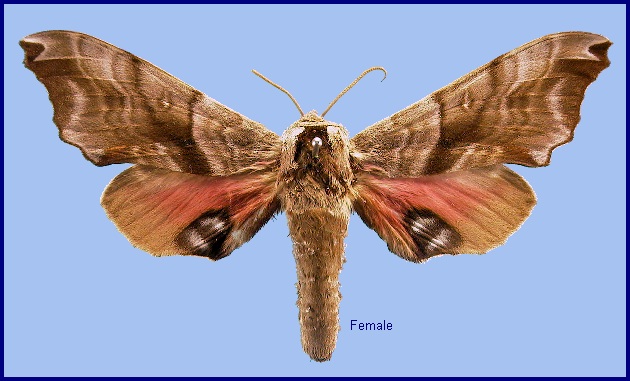
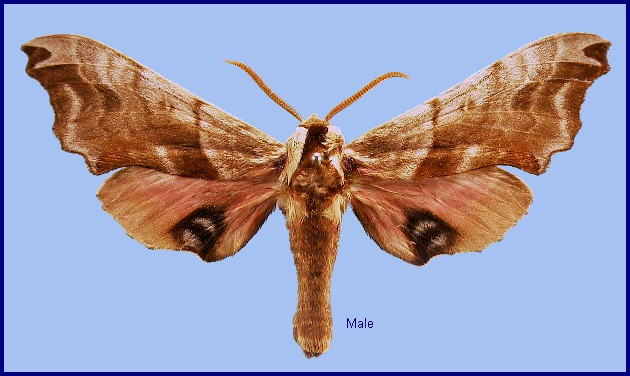
Smerinthus caecus Ménétriés, 1857, Enumeratio Corporum Anim. Mus. imp. Acad. Sci. Petropolitanae (Ins. Lepid.) 2 (Lepid. Heterocera): 135. Type locality: [Russia, Chitinskaya Oblast,] "Dahuria?".
[Further details on this species in Japan, as well as photos of many stages, can be found on Digital Moths of Japan.]
Wingspan: 50--70mm. Sexually dimorphic. Very like a small Smerinthus ocellata, but with incomplete small black ocelli containing two small blue streaks. The foretibia lacks an apical thorn. Variation even less than in Smerinthus ocellata, mainly consisting of differences in the amount of blue in the ocelli, and in the intensity of forewing markings.
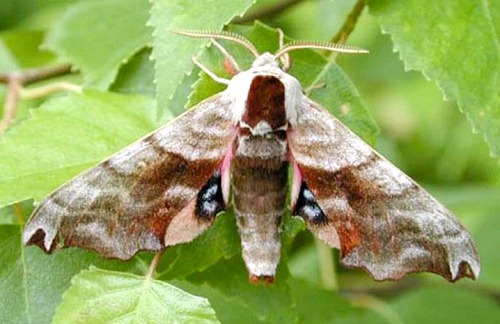
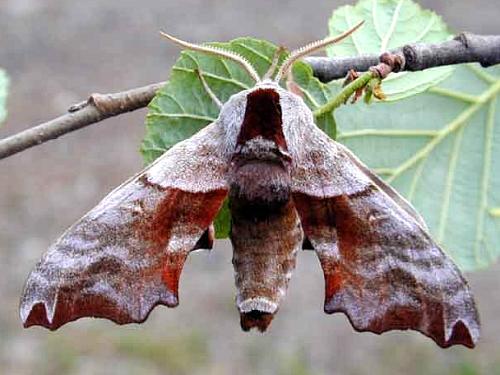
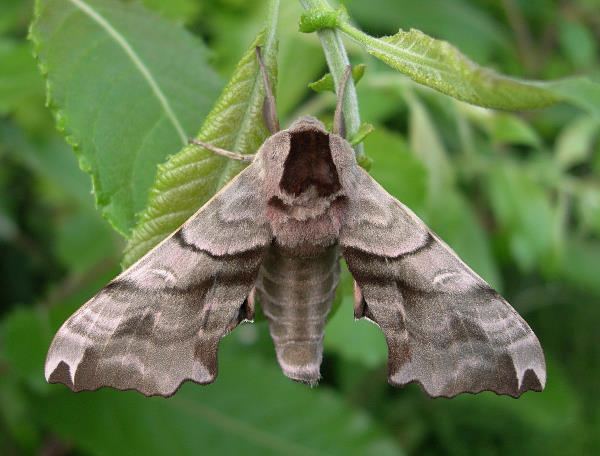
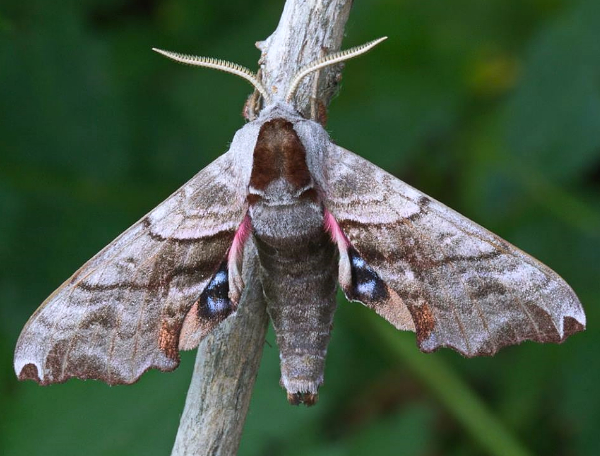
In the Russian Far East, a species of mixed forests of conifers and deciduous trees, and deciduous woodland in valley bottoms (Izerskiy, 1999b). Farther west, in Siberia, this species not only occurs in mixed forests, but also in small, isolated patches of deciduous woodland in the steppe belt (e.g. around Karasuk, southern part of Novosibirsk Province (V. Dubatolov, pers. comm. 2010)); however, Salix must always be present. Around Karasuk this species is much rarer than Smerinthus ocellata (V. Dubatolov, pers. comm. 2010). Females active from 23.00h until 01.20h, males from 23.00h until 03.50 (Izerskiy, 1999b). The female lays up to 150 eggs, singly or in small groups of up to 8-12, on leaves of the hostplant. These develop in 7-8 days (Chistyakov, 1988).
One of the most common species in the south of the Russian Far East, where it causes moderate damage to various broad-leaved species, but appreciable damage is done only to poplar saplings in forest nurseries (Chistyakov, 1988).
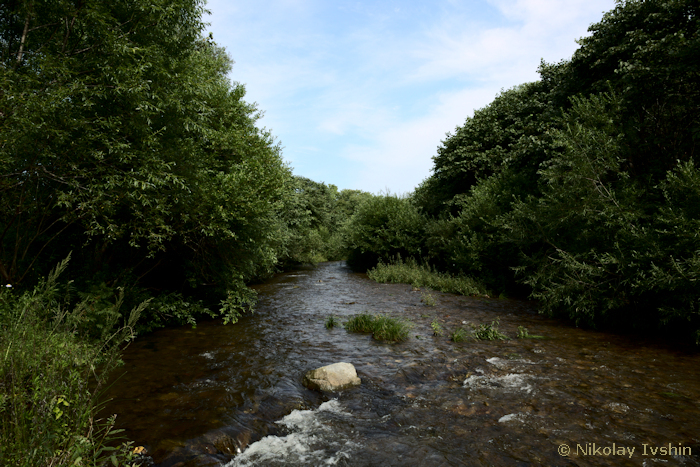
China: v (Jiguanshan; Yanbian; Mudanjiang City); vi (Great Khingan Mountains, Zalantun/Butha Qi; Jilin; Beijing; Tieling); vii (Hailin; Chifeng/Ulanhad; Huairou County; Heilongjiang; Jilin; Liaoning; Hubei); vii-viii (Lalin), viii (Lesser Khingan Mountains, ??Chesig-Chin). Mongolia: 30.vii (Khalkhin-Gol). North Korea: vi (Sinmi-do; Muhak-san, Kilju City); vii (Chonma-san; Jueul). South Korea: 2.vii [(unstated locality]). Japan: 13.vi-26.vii (Hokkaido). Russia: 25.v-14.viii (Khabarovskiy Krai); 26.v-2.ix (Primorskiy Krai); vi (Sakhalin Island; Kurile Islands); 15.vi-24.vii (Siberia); 23.vi-19.vii (Khabarovskiy Krai); vii (Amurskaya); 11.vii (Transbaikalia); 17.vii (Sakhalin Island).
Mainly univoltine; late May to early August, depending on latitude and altitude. Commonest from mid June until mid July. Izerskiy (1999b) states that in years when a partial second brood occurs in the Russian Far East, moths can be found in May\June and in August\September. This supports the claim of Yang (1978) that Smerinthus caecus has two generations a year in China.
Park et al. (1999) give late May until mid August as the flight period in Korea.
OVUM: Whitish-green, oval (2mm).
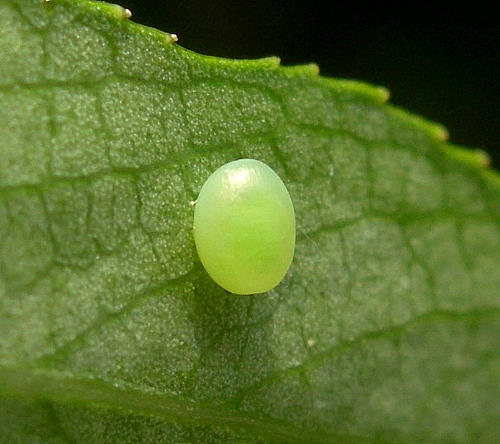
LARVA: Full-fed 60--70mm. Dichromatic; bluish-green and yellow-green. Resembles that of Smerinthus ocellata. Both colour forms of Smerinthus caecus have some black markings/tubercles on the dorsal surface of the horn, base of the claspers, prolegs, and ventral surface of the head. There may also be red edging to the oblique lateral stripes and spiracles. The white/yellow body tubercles are round and blunt, unlike in Smerinthus ocellata, where they are sharp and pointed. Like Laothoe amurensis, may go through four or five instars, depending on the quality of the host (Klaas van Haeringen, pers. obs. 2016).
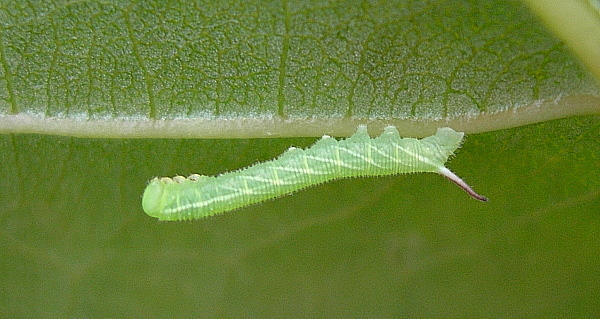
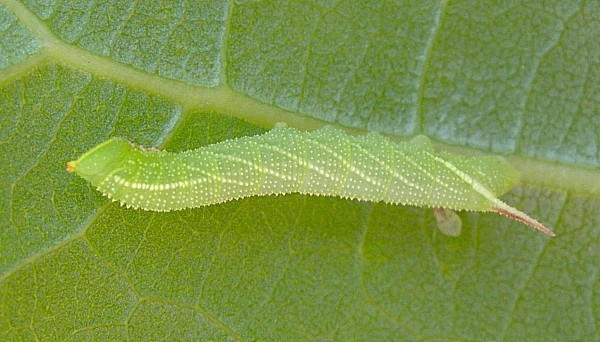
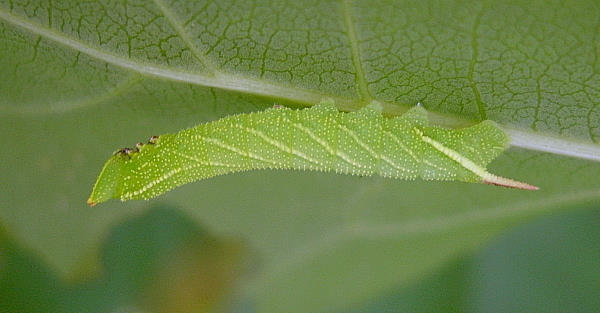
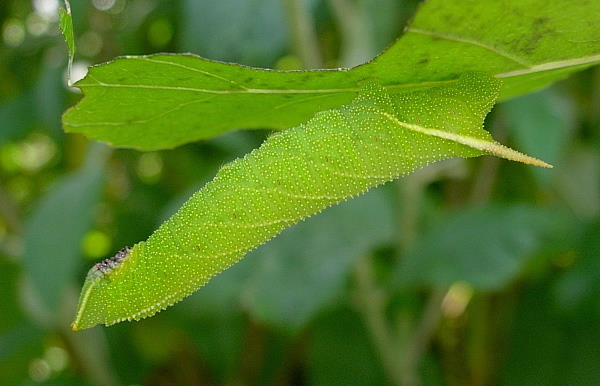
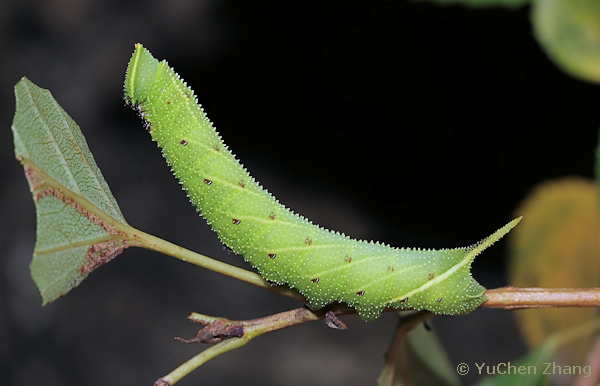
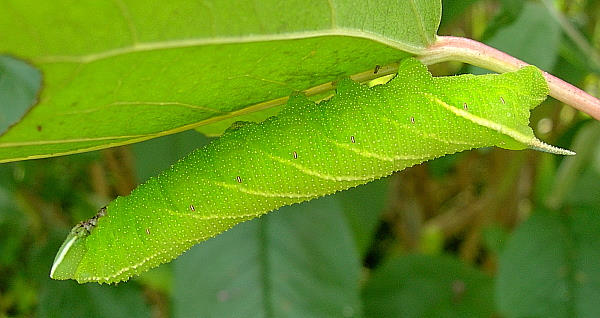
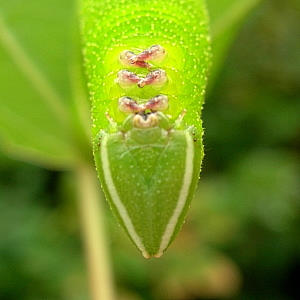
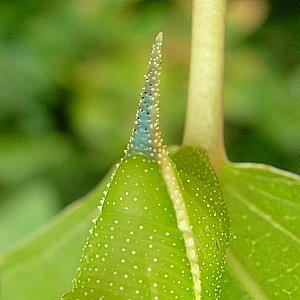
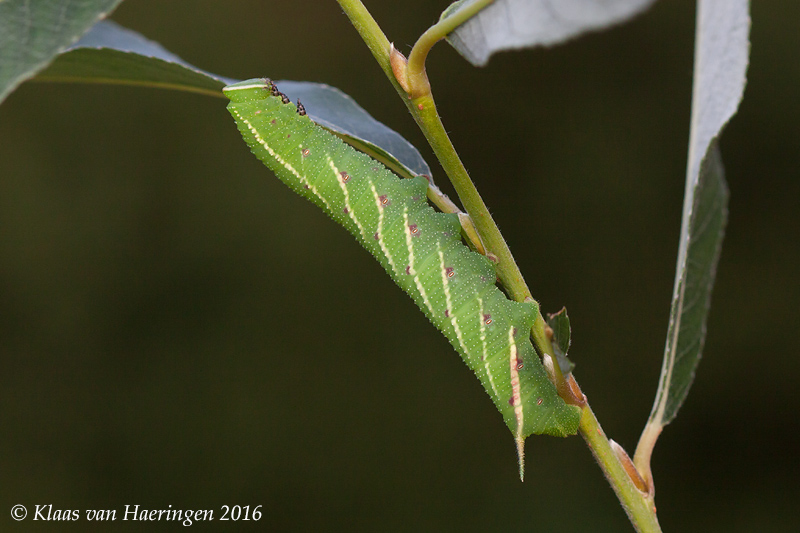
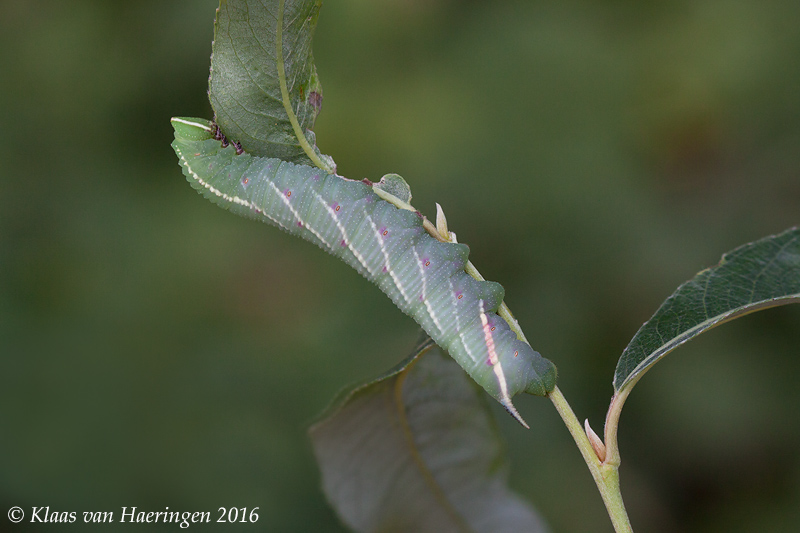
PUPA: 31--35mm. Almost identical to that of Smerinthus ocellata. The overwintering stage.
Larval hostplants. Recorded on Populus in China (Yang, 1978; Chu & Wang, 1980) and on Salix in Primorskiy Krai, Russia (Graeser, 1888). Li & Guo (1990) give Salix and Populus alba for Shanxi.
Izerskiy (1999b) states that the main hosts in the Russian Far East are species of Salix, less often Populus tremula and Betula. Chistyakov (1988) also gives Populus davidi.
Recorded in Korea on Populus maximowiczii (Park et al., 1999).
Unknown.
China: Nei Mongol (Zalantun/Butha Qi, Great Khingan Mountains; Chifeng/Ulanhad, Daguangdingzishan, 2061m; Ergun Youqi; Hulunbuir Region, Sanhaodian); Heilongjiang (Hailin; Lalin; ??Chesig-Chin, Lesser Khingan Mountains; Mudanjiang City; Pingshan); Jilin (Jiaohe, Lafa Shan; Yanbian; Changbai Shan); Liaoning (Jiguanshan; Changhai, Dachangshan Island; Tieling; Benxi); Hebei (Chengde); Beijing (Shentangyu Natural Scenic Area, Huairou County); Shanxi (Taiyuan; Taigu; Qixian); Hubei (Luotian).
Mongolia: Dornod Province (Khalkhin-Gol); Selenge Province (Tunkhel Village, Khailaast; Baruun kharaa soum, Bayangol; Zuunburen Soum, Gangiin tokhoi; Khushaat).
North Korea: Kangwon Province (Keumgang-san); North Pyongan Province (Sinmi-do; Chonma-san); South Pyongan Province (Pyongyang); South Hamgyong Province (Seokwang Temple; Hagal; Gyungsung; Nangnimsan); North Hamgyong Province (Jueul, 1500m; Muhak-san, Kilju City).
South Korea: Seoul; Kyonggi Province (Gwangleung; Chukryong-san); Kangwon Province (Daeryong-san; Gwangduk-san; Seolak-san; Yangyang; Odae-san; Woljeong Temple; Baekduk-san; Taebek-san; Yanggu; Bongmyung-ri; Bangtae-san; Dunnae; Chiak-san); South Cholla Province (Mokpo); North Kyongsang Province (Sobaek-san; Cheongyang-san; Seongju); South Kyongsang Province (Gibaek-san; Hamyang).
Japan: Hokkaido (Kushiro; Tokachi; Lake Taisetsu; Kamikawa); northern Honshu.
Russia: Siberia (Tomsk; Khromovka; Kireevsk; Kolomino; Bazoy; Bakchar; Tyul'ka; Novosibirsk; Kayly; Shirokaya; Chingisy; Abaza; Khandyrgey; West Sayan Mts.; East Sayan Mts., 2000m; Malchan Mts., Borochojewa, 800m; Alaevo; Irkutsk; Krasnoyarsk); Tuva ASSR (Khondyrgey; Erzin); Buryatia (Muya; Deben; Atsula; Posolskaya; Mostovoi; Murochi; Ulan-Ude; Sotnikovo; Onokhoy village); Transbaikalia (Kurleya Village; Nizhnii Tsasuchei; Novaya Kuka; Tankha; Butyvken; Chita; Mogocha; Tupik; 60 km SE from Amazar; Kuenga; Argunsk; Shara; Kyra; Sokhondinskii Nature Reserve (Agutsa, Nizhnii Bukukun); Bogomyakovo; Undino-Posel'e; Budymkan; Ur'upino; Daurskii Nature Reserve); Amurskaya (Teply Klyuch; Zeiskii/Zeysky Nature Reserve; Blagoveshchensk; Uril; Tynda; Zeya; Tygda; Mukhino; Shimanovsk; Pashkovo, and many other places); Yevreyskaya (Radde; Bastak Nature Reserve); Khabarovskiy Krai (Slavyanka; Novoaleksandrovka; Khabarovsk; Bolshekhekhtsyrskii Nature Reserve, Khabarovsk suburbs; Duki; northern Bureinskii/Bureya Hills; Bureinskii/Bureya Nature Reserve; Lidoga; Innokent'evka; Komsomolsk-na-Amure; Pivan; Kiselevka; Nikolaevsk-na-Amure; Chlya; Botchinskii Nature Reserve; Tumninsky Nature Reserve); Kamchatka; Primorskiy Krai (Andreevka; Kaymanovka; Kamenushka; Anuchino; Ussuriysk; Khasan; Kedrovaya Pad Nature Reserve; Novovladimirovka; near Kalinovka; near Zanadvorovka; Kravtsovka; Anisimovka; Dalnegorsk); Kurile Islands; Sakhalin Island (Shebunino; Yuzhno-Sakhalinsk).
Ranges across Russia, from St. Petersburg and Moscow, to the Pacific coast islands (Chistyakov, 1988; Danner et al., 1998), and south to the Altai Mountains (Danner et al., 1998), Mongolia (Chistyakov, 1988; Puntsagdulam et al., 2005; Enkhtur, 2021; Enkhtur, Brehm, Boldgiv & Pfeiffer, 2021), northeastern China (southwest as far as Shanxi; Li & Guo, 1990), South Korea (Kim et al., 1982) and Japan (Hokkaido; northern Honshu). The European distribution is uncertain due to confusion with Smerinthus ocellata ocellata (Linnaeus), as demonstrated by the history of its discovery in Europe and Siberia. Djakonov (1911) recounted how Duske collected two specimens in the Ural Mountains in the 1890s, but other entomologists discounted this. A further specimen was captured in 1895 by Keller at Aleksino (Tula district), while four more moths were caught in June 1908 at Ekaterinburg (Djakonov, 1911). Soon after, Filipjev (1912) reported rearing an adult female from a larva found at Torbino (Novgorod district), while Sheljuzhko (1924) noted an adult female captured on 22.v.1915 at Belebej-Aksakovo (Ufa district). He speculated that either Smerinthus caecus was always present in Europe and simply overlooked (the view of Djakonov), or that it only recently spread west from Siberia (the view of Filipjev). The latter view is probably correct.
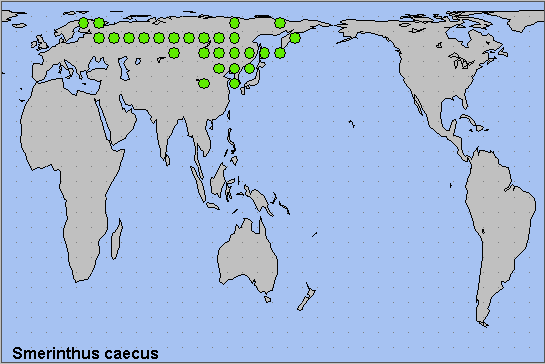
Holarctic; Palaearctic (both eastern and western). Pleistocene refuge: Monocentric -- Manchurian.
 Return to Sphingidae of the Eastern Palaearctic species list
Return to Sphingidae of the Eastern Palaearctic species list